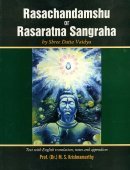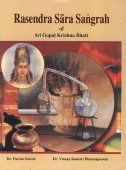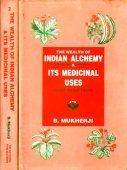Mica: 2 definitions
Introduction:
Mica means something in Hinduism, Sanskrit. If you want to know the exact meaning, history, etymology or English translation of this term then check out the descriptions on this page. Add your comment or reference to a book if you want to contribute to this summary article.
In Hinduism
Ayurveda (science of life)
Rasashastra (Alchemy and Herbo-Mineral preparations)
Source: Google Books: The Alchemical Body
Mica (called abhraka, gagana, vyoma or kha), one of the three major mineral manifestations of the Goddess. Mica is already identified with the Goddess’s sexual emission in the Rasārṇava and Rasaratnasamucchaya.
A short account of its origin is found in the Rasakāmadhenu:
“One day the hillborn Goddess saw the mind-boggling Hara; the ‘semen’ (vīrya) she shed produced brilliant mica.”
The Rasendra-bhāskara reproduces this account with minor emendations, adding that
“because it fell from the firmanent (gaganāt) it is also called gagana; because it wandered (abhramāt) through the clouds (abhra), it is called abhraka.”
These are the two principal Sanskrit terms for mica.
Another name for mica, the Goddess’s sexual emission, is vyoma. Now, vyoma is also, at least from the time of the Suśruta-saṃhitā, a term used for the element ether, which is identified, in Sāṃkhya, as the substrate of the sound tanmātra as well as o the sense of hearing. Like vyoma, gagana and kha are also terms that signify both mica and ether. Located as it is at the summit of the hierarchy of the five elements, ether is, both temporally and logically the first of the elements that emanates from the second guṇa, rajas.

Āyurveda (आयुर्वेद, ayurveda) is a branch of Indian science dealing with medicine, herbalism, taxology, anatomy, surgery, alchemy and related topics. Traditional practice of Āyurveda in ancient India dates back to at least the first millenium BC. Literature is commonly written in Sanskrit using various poetic metres.
Shilpashastra (iconography)
Source: Shodhganga: Elements of Art and Architecture in the Trtiyakhanda of the Visnudharmottarapurana (shilpa)Mica is denoted by the Sanskrit term Abhraka and represents one of the materials used to make Colours in the ancient Indian tradition of Painting (citra), according to the Viṣṇudharmottarapurāṇa, an ancient Sanskrit text which (being encyclopedic in nature) deals with a variety of cultural topics such as arts, architecture, music, grammar and astronomy. In the Viṣṇudharmottarapurāṇa, various materials are seen to be used to make colours. e.g., Mica (abhraka). Also, five colours are regarded as the primary ones, (viz., white, yellow, colour of vilomata, black, dark blue.). A painter can create hundreds or thousands of colours by amalgamating the primary colours.

Shilpashastra (शिल्पशास्त्र, śilpaśāstra) represents the ancient Indian science (shastra) of creative arts (shilpa) such as sculpture, iconography and painting. Closely related to Vastushastra (architecture), they often share the same literature.
See also (Relevant definitions)
Starts with (+6): Micaha, Micai-patumpul, Micainar, Micaittiral, Micaivatam, Micaivu, Micaka, Micakana, Micakanem, Micakata, Micakatanem, Micakavani, Micakavinem, Micakuta, Mical, Micalana, Micali, Micalpanti, Micamica, Micamicita.
Ends with: Aesculus assamica, Amentotaxus assamica, Dharmadharmica, Gairasomica, Gomica, Hamica, Hamidhumica, Kiramica, Mastersia assamica, Medinilla assamica, Mesua assamica, Micamica, Naimica, Nux-vomica, Samica, Shorea assamica, Strychnos nux-vomica, Thicamica, Vamica, Vitex megapotamica.
Full-text (+76): Abhraka, Abhra, Gagana, Carana, Vyomakhya, Mikakkal, Abaraka, Kalaabhraka, Pandhara-abhraka, Pandhara Abhraka, Ambara, Kiruttinappirakam, Kantakappirakam, Kantarappacci, Khasatva, Bimgusubu, Amparainatam, Kevunam, Pirakacatti, Vyoman.
Relevant text
Search found 24 books and stories containing Mica; (plurals include: Micas). You can also click to the full overview containing English textual excerpts. Below are direct links for the most relevant articles:
Rasa Jala Nidhi, vol 1: Initiation, Mercury and Laboratory (by Bhudeb Mookerjee)
Part 12 - Mercurial operations (10): Swallowing of metals of Mercury (grasana) < [Chapter IV-V - Mercurial operations]
Part 15 - Mercurial operations (13): Internal liquefaction of mercury (garbhadruti) < [Chapter IV-V - Mercurial operations]
Part 20 - Mercurial operations (18): Transformation of base metals into gold by mercury (bedhana) < [Chapter IV-V - Mercurial operations]
Rasa Jala Nidhi, vol 2: Minerals (uparasa) (by Bhudeb Mookerjee)
Part 5 - Killing (incineration) of Mica < [Chapter I - Uparasa (1): Abhra or Abhraka (mica)]
Part 1 - Characteristics of Mica (abhra or abhraka) < [Chapter I - Uparasa (1): Abhra or Abhraka (mica)]
Part 6 - Use of incinerated mica < [Chapter I - Uparasa (1): Abhra or Abhraka (mica)]
Rasa Jala Nidhi, vol 5: Treatment of various afflictions (by Bhudeb Mookerjee)
Chapter 3 - Symptoms and treatment of Kasa (cough)
Chapter 6 - Diseases affecting the heart (hridroga)
Chapter 8 - Symptoms and treatment of Amlapitta (acidity and biliousness)
Rasa Jala Nidhi, vol 3: Metals, Gems and other substances (by Bhudeb Mookerjee)
Part 8 - Uses of Diamond < [Chapter XIII - Gems (1): Vajra or Hiraka (diamond)]
Part 4 - Use of brass < [Chapter VIII - Mixed metals (1): Pittala (brass)]
Part 7 - Uses of Vaikranta < [Chapter XX - Gems (8): Vaikranta (garnet)]
Rasa Jala Nidhi, vol 4: Iatrochemistry (by Bhudeb Mookerjee)
Treatment for fever (170): Chandrodaya rasa < [Chapter II - Fever (jvara)]
Part 19 - Treatment for diarrhea (10): Girisha-sundara rasa < [Chapter III - Jvaratisara fever with diarrhoea]
Part 70 - Treatment for chronic diarrhea (42): Shiva-sadhana rasa < [Chapter III - Jvaratisara fever with diarrhoea]
The Sarva-Darsana-Samgraha (by E. B. Cowell)
Related products




